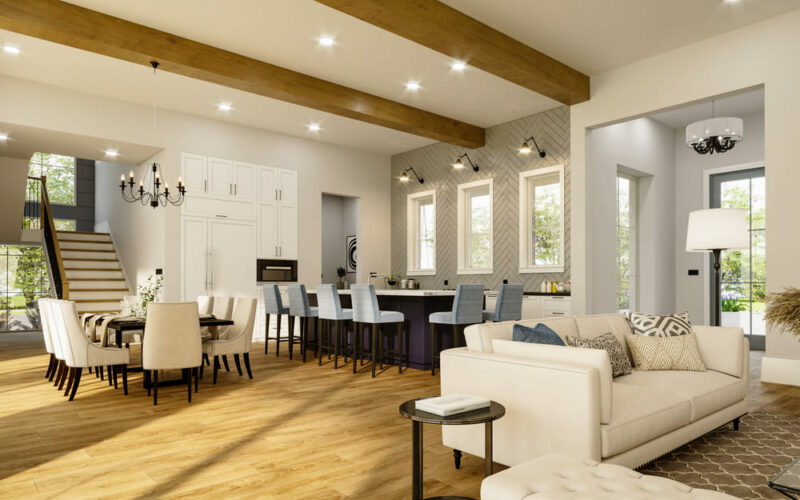In the ever-evolving field of interior design, how professionals plan and visualize their projects has undergone a remarkable transformation. Gone are the days when designers solely relied on 2D drawings and physical mock-ups to convey their ideas to clients. Today, Virtual Reality (VR) and Augmented Reality (AR) have emerged as powerful tools that revolutionize interior design visualization. These immersive technologies allow designers to create interactive, three-dimensional representations of spaces, enabling clients to explore and engage with their designs in ways previously thought impossible. In this comprehensive two-part article, we will delve deep into the role of VR and AR in interior design, exploring their applications, benefits, and the future they promise. (Visit Yousee Studio for more information.)
The Evolution of Interior Design Visualization
Interior design has always been a visual art; traditionally, designers have employed various tools to bring their ideas to life. These tools include sketches, floor plans, and physical models. While effective, these methods had limitations in conveying the whole experience of a designed space. Clients often need help to envision the final result based on 2D drawings or static models. This gap between conception and realization led to the exploration of new technologies.

The Emergence of 3D Visualization
As computers became more powerful and accessible, designers started to adopt 3D visualization software. These tools allowed them to create three-dimensional renderings of spaces, giving clients a better understanding of the proposed designs. However, these early 3D models were typically displayed on flat screens, limiting the immersive qualities of the experience.
Enter Virtual Reality (VR)
The breakthrough moment for interior design visualization came with the integration of VR technology. VR takes 3D modeling to the next level by allowing users to step into a virtual representation of a space. With the help of specialized headsets, clients and designers alike can explore rooms, move furniture, and experience the design as if they were physically present. This level of immersion has proven to be a game-changer in the industry.
Benefits of VR in Interior Design
- Immersive Exploration: VR enables clients to walk through and interact with their future spaces. They can get a sense of scale, proportion, and spatial flow that is impossible to achieve through traditional methods.
- Realistic Material Representation: VR can simulate different materials and finishes, giving clients a realistic preview of how various surfaces look and feel.
- Streamlined Communication: Designers can communicate their ideas more effectively. Clients can provide feedback based on virtual experiences, leading to more refined designs.
- Cost and Time Savings: Early detection of design issues in the virtual environment can prevent costly revisions during the physical construction phase.
Augmented Reality (AR): Bridging the Physical and Digital
While VR immerses users in entirely virtual environments, Augmented Reality (AR) takes a different approach. AR overlays digital information onto the physical world, effectively blending the two. For interior design, designers can enhance a client’s perception of their existing space or the potential of a new one.
AR Applications in Interior Design
- Furniture Placement: Using AR apps, clients can visualize how furniture and decor items will fit into their rooms. This helps in making informed decisions about purchases.
- Color and Material Selection: AR allows users to test different paint colors or materials in real time. This feature is invaluable for choosing the perfect palette.
- Interactive Shopping: Some retailers offer AR apps that allow users to see how products would look in their homes before making a purchase. This reduces the likelihood of returns.
- Guided Home Tours: AR can provide guided tours of properties for sale or rent. Users can point their devices at a room, and relevant information appears on the screen.
VR and AR: A Harmonious Duo
In recent years, designers have recognized that VR and AR are not mutually exclusive but can complement each other beautifully. While VR offers the depth of immersion and spatial understanding, AR enhances real-world interactions. This synergy between the two technologies opens up exciting possibilities.
Design Collaboration in VR
VR is not just for client presentations; it’s also a powerful tool for collaboration among design teams. Designers can meet in virtual spaces to discuss projects, make real-time design changes, and better understand how areas will function.
AR for Real-Time Design Feedback
On the other hand, AR can be used on-site during construction or renovation projects. Designers can overlay digital plans onto the physical space, ensuring that every detail aligns with the original vision. Any discrepancies can be spotted and addressed immediately, reducing errors and costly rework.
The Future of VR and AR in Interior Design
As technology advances, VR and AR are expected to become more integral to interior design. They will likely be used from the initial concept stage to project completion. The ability to create immersive, interactive, and dynamic design experiences will set the industry on an exciting trajectory.
Practical Applications and Implementation

Virtual Property Walkthroughs
One of the significant applications of VR and AR in interior design is revolutionizing how potential buyers or renters experience properties. Instead of physically visiting a location, clients can take a virtual tour of their homes. Real estate agencies and interior designers can create immersive 3D models of houses, apartments, or commercial spaces.
Advantages
- Global Reach: Properties can be showcased worldwide without physical visits.
- Time and Cost Savings: Buyers can significantly narrow their options before arranging on-site visits.
- Interactive Experience: Clients can interact with the space, moving furniture virtually and assessing design possibilities.
Designing for Accessibility
VR and AR also have the potential to make spaces more accessible for individuals with disabilities. Designers can use these technologies to simulate how areas will function for people with various mobility challenges, allowing for better design decisions.
Benefits
- Inclusive Design: VR and AR enable designers to consider the needs of a broader range of users.
- Early Problem Detection: Potential accessibility issues can be identified early in the design phase.
- Client Empowerment: Clients with specific accessibility requirements can actively participate in the design process.
Remote Design Consultations
The global nature of interior design projects often involves designers working with clients from different locations. VR and AR can facilitate remote design consultations, making it easier for designers to collaborate with clients worldwide.
Advantages
- Real-Time Feedback: Clients can provide immediate feedback on design elements as if they were physically present.
- Reduced Travel Costs: Designers and clients can save on travel expenses.
- Enhanced Communication: The visual and interactive nature of VR and AR fosters better communication.
Overcoming Challenges
While VR and AR offer tremendous potential, there are challenges that the interior design industry must address for these technologies to be fully integrated.
Cost of Entry
Implementing VR and AR technology can be expensive, especially for small design firms or freelance designers. The initial hardware, software, and training investment can be a barrier.
Solutions
- Affordable Alternatives: Look for more cost-effective VR and AR solutions catering to the design industry’s needs.
- Collaboration: Consider collaborating with firms specializing in VR and AR to share costs and expertise.
Technical Expertise
Creating VR and AR experiences requires technical expertise many traditional designers may not possess. Learning new software and techniques can be time-consuming.
Solutions
- Training: Invest in training programs or courses that teach the necessary skills.
- Hiring or Outsourcing: Consider hiring professionals with VR and AR expertise or outsourcing these aspects of a project.
User Experience
While VR and AR offer incredible immersion, designers must ensure that these technologies enhance the user experience rather than detract from it. Clunky or poorly designed VR or AR experiences can have the opposite effect.
Solutions
- User Testing: Continuously test VR and AR experiences with end-users to identify and address usability issues.
- Simplicity: Keep designs simple and intuitive to prevent overwhelming users.
The Future of VR and AR in Interior Design
Enhanced Design Iteration
The iterative process of design can be time-consuming and costly. With VR and AR, designers can rapidly create and visualize design variations. This speeds up the design phase and allows clients to make informed decisions more quickly.
Benefits
- Faster Design: Iterations that once took weeks can now be done in days or even hours.
- Client Collaboration: Clients can actively participate in the design process by exploring various real-time options.
Sustainable Design
Sustainability is a growing concern in the interior design industry. VR and AR can help designers simulate the environmental impact of design choices, such as energy consumption and material use.
Advantages
- Eco-Friendly Design: VR and AR can guide designers towards more sustainable choices.
- Cost Reduction: Sustainable designs can lead to long-term cost savings for clients.
The Next Level of Customization
Personalization is a critical trend in interior design. VR and AR can take customization to new heights by allowing clients to visualize highly tailored design solutions.
Benefits
- Tailored Experiences: Clients can see exactly how a design will suit their unique preferences and lifestyle.
- Competitive Advantage: Design firms that offer this level of customization gain a competitive edge.
Conclusion
The fusion of Virtual Reality (VR) and Augmented Reality (AR) with interior design has unlocked a realm of possibilities that were once the stuff of science fiction. These technologies have redefined how designers and clients interact with spaces, from providing immersive property walkthroughs to enabling remote design consultations. However, navigating the challenges, including cost, technical expertise, and user experience, is essential to leverage VR and AR potentialAR’s potential fully.
As technology advances and becomes more accessible, the interior design industry stands at the threshold of a transformative era. VR and AR will not replace the traditional design process but enhance and complement it, offering more efficient workflows, sustainable solutions, and highly customized designs. With the right balance of creativity and technology, the future of interior design looks more exciting than ever.













